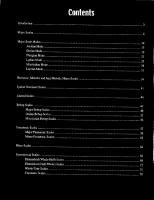Mel Bay Learning the Classic Guitar: Part 1 0871668548, 9780871668547
Learning the Classic Guitar is a new direction in guitar instruction. Many ideas in these books break new ground. In dev
294 88 29MB
English Pages 162 Year 1990
Table of contents :
Cover
Dedication
Acknowledgments
Table of Contents
Preface
Introduction
Using These Books
The Classic Guitar
"Classic" or "Classical" Guitar?
Tuning the Guitar
Playing Condition of the Guitar
Determining the Action of a Guitar
Choosing a Teacher
Approaching Guitar Study
Your Goal: Sharing Music
Essentials for Performance
Avoiding Habits of Confusion and Error
Aim-Directed Movement
Developing Sustained Concentration
Guidelines for Study and Practice
Summary
The Four Principles of Efficient Muscle Function
Summary
Positioning the Guitar
General Positioning
The Five Ways of Moving the Guitar
The Right- and Left-Hand Position Checks
Adjusting Your Position
An Alternative to Using the Footstand Alone
Summary
Tone Production
Principles of Tone Production
Tone Quality and Your Nails
Nail Contours and Suggested Shapings
Summary
Beginning Right-Hand Training
Terms and Symbols
Right-Hand Positioning
Rest-Stroke and Free-Stroke
The Prepared-Stroke
Training P: The Prepared Free-Stroke
Sounding the Strings
The Continuity-Stroke
Summary
Beginning Left-Hand Training
Before You Begin
Left-Hand Positioning
Left-Hand Movement
Movement by Touch: Applying Aim-Directed Movement (ADM)
Training the Right-Hand Fingers
Training the Inactive Fingers
The Prepared Rest-Stroke
The Continuity Rest-Stroke
Alternation of a Finger Rest-Stroke and P Free-Stroke
Beginning Free-Stroke with Your Fingers
Before You Begin
Free-Stroke Considerations
I-M Free-Stroke
Tip Joint Considerations
I-M and P Alternation
I-M-A Free-Stroke
I-M-A and P Alternation
Sympathetic Movement
P,I,M
P,I,M-A
P,I-M,A
Alternation
Beginning Free-Stroke Alternation: P,I,M,I,
Left-Hand Considerations
P,I,A
Alternating I and M on Adjacent Strings
Alternating I and M on a Single String
Principles of String Crossing
Beginning String Crossing
Clarity on Wound Strings
Sounding a Single Note Free-Stroke on an Adjacent String
M and A Alternation
Developing Right-Hand Speed
Developing Independence through Opposed-Finger Sweeps
Integrating Independence and Control
Summary
Comparing Rest-Stroke and Free-Stroke
Rest-Stroke Finger Alternation
Sounding Three Strings Together with P and the Fingers
Sounding Two Strings Together with P and One Finger
P,I,M,A
P,I,M,A,M,I
Four Strings Simultaneously with P-I-M-A
Further Left-Hand Training
Applying the Principles of Efficient Muscle Function
Developing Left-Hand Mobility
Slurs
Technical Slurs
Types of Downward Slurs
Further Right-Hand Training
Arpeggios without P
A,M,I
I,M,A
A,M,I,M
I,A,M,A
A,I,M,I
Conditioning and Coordination Exercise
The Importance of Stretching Exercises
Procedure for Stretching Exercises
Developing Muscular Coordination
Coordination Exercises
The Remedial Student
Summary
The Natural Approach
Determining the Most Natural Approach
The Misuse of "Just Let It Happen"
Summary
Economy of Movement
Summary
Repetitive Strain Injury (RSI)
Coordination and Counterproductive Tension
How RSI Develops
Musicians Who Develop RSI
Questions about RSI
Overcoming RSI
Summary
Avoiding Chronic Shoulder Pain
Learning to Recognize Correct Arm Movement
Procedure for Training the Right Shoulder
Summary
Index
Cover
Dedication
Acknowledgments
Table of Contents
Preface
Introduction
Using These Books
The Classic Guitar
"Classic" or "Classical" Guitar?
Tuning the Guitar
Playing Condition of the Guitar
Determining the Action of a Guitar
Choosing a Teacher
Approaching Guitar Study
Your Goal: Sharing Music
Essentials for Performance
Avoiding Habits of Confusion and Error
Aim-Directed Movement
Developing Sustained Concentration
Guidelines for Study and Practice
Summary
The Four Principles of Efficient Muscle Function
Summary
Positioning the Guitar
General Positioning
The Five Ways of Moving the Guitar
The Right- and Left-Hand Position Checks
Adjusting Your Position
An Alternative to Using the Footstand Alone
Summary
Tone Production
Principles of Tone Production
Tone Quality and Your Nails
Nail Contours and Suggested Shapings
Summary
Beginning Right-Hand Training
Terms and Symbols
Right-Hand Positioning
Rest-Stroke and Free-Stroke
The Prepared-Stroke
Training P: The Prepared Free-Stroke
Sounding the Strings
The Continuity-Stroke
Summary
Beginning Left-Hand Training
Before You Begin
Left-Hand Positioning
Left-Hand Movement
Movement by Touch: Applying Aim-Directed Movement (ADM)
Training the Right-Hand Fingers
Training the Inactive Fingers
The Prepared Rest-Stroke
The Continuity Rest-Stroke
Alternation of a Finger Rest-Stroke and P Free-Stroke
Beginning Free-Stroke with Your Fingers
Before You Begin
Free-Stroke Considerations
I-M Free-Stroke
Tip Joint Considerations
I-M and P Alternation
I-M-A Free-Stroke
I-M-A and P Alternation
Sympathetic Movement
P,I,M
P,I,M-A
P,I-M,A
Alternation
Beginning Free-Stroke Alternation: P,I,M,I,
Left-Hand Considerations
P,I,A
Alternating I and M on Adjacent Strings
Alternating I and M on a Single String
Principles of String Crossing
Beginning String Crossing
Clarity on Wound Strings
Sounding a Single Note Free-Stroke on an Adjacent String
M and A Alternation
Developing Right-Hand Speed
Developing Independence through Opposed-Finger Sweeps
Integrating Independence and Control
Summary
Comparing Rest-Stroke and Free-Stroke
Rest-Stroke Finger Alternation
Sounding Three Strings Together with P and the Fingers
Sounding Two Strings Together with P and One Finger
P,I,M,A
P,I,M,A,M,I
Four Strings Simultaneously with P-I-M-A
Further Left-Hand Training
Applying the Principles of Efficient Muscle Function
Developing Left-Hand Mobility
Slurs
Technical Slurs
Types of Downward Slurs
Further Right-Hand Training
Arpeggios without P
A,M,I
I,M,A
A,M,I,M
I,A,M,A
A,I,M,I
Conditioning and Coordination Exercise
The Importance of Stretching Exercises
Procedure for Stretching Exercises
Developing Muscular Coordination
Coordination Exercises
The Remedial Student
Summary
The Natural Approach
Determining the Most Natural Approach
The Misuse of "Just Let It Happen"
Summary
Economy of Movement
Summary
Repetitive Strain Injury (RSI)
Coordination and Counterproductive Tension
How RSI Develops
Musicians Who Develop RSI
Questions about RSI
Overcoming RSI
Summary
Avoiding Chronic Shoulder Pain
Learning to Recognize Correct Arm Movement
Procedure for Training the Right Shoulder
Summary
Index


![Mel Bay Aaron Shearer Learning the Classic Guitar, part 3 (Book & CD) [BK&CD ed.]
0786632097, 9780786632091](https://ebin.pub/img/200x200/mel-bay-aaron-shearer-learning-the-classic-guitar-part-3-book-amp-cd-bkampcdnbsped-0786632097-9780786632091.jpg)






![Mel Bay You Can Teach Yourself Guitar [Pap/DVD ed.]
9780786667826, 0786667826](https://ebin.pub/img/200x200/mel-bay-you-can-teach-yourself-guitar-pap-dvdnbsped-9780786667826-0786667826.jpg)
